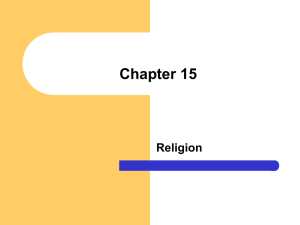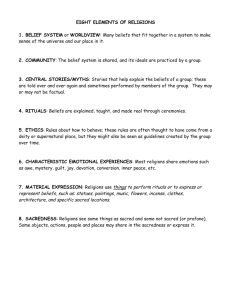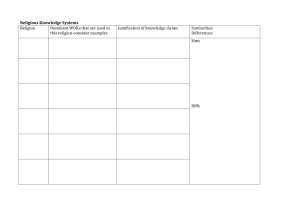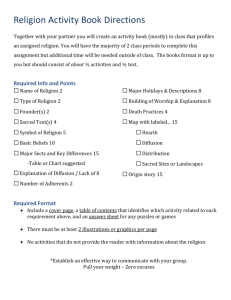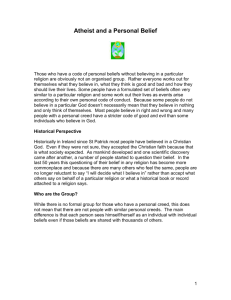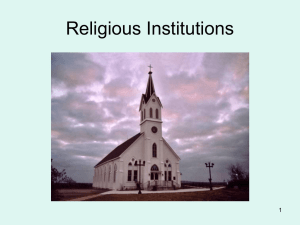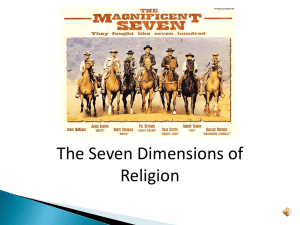Course Title
advertisement
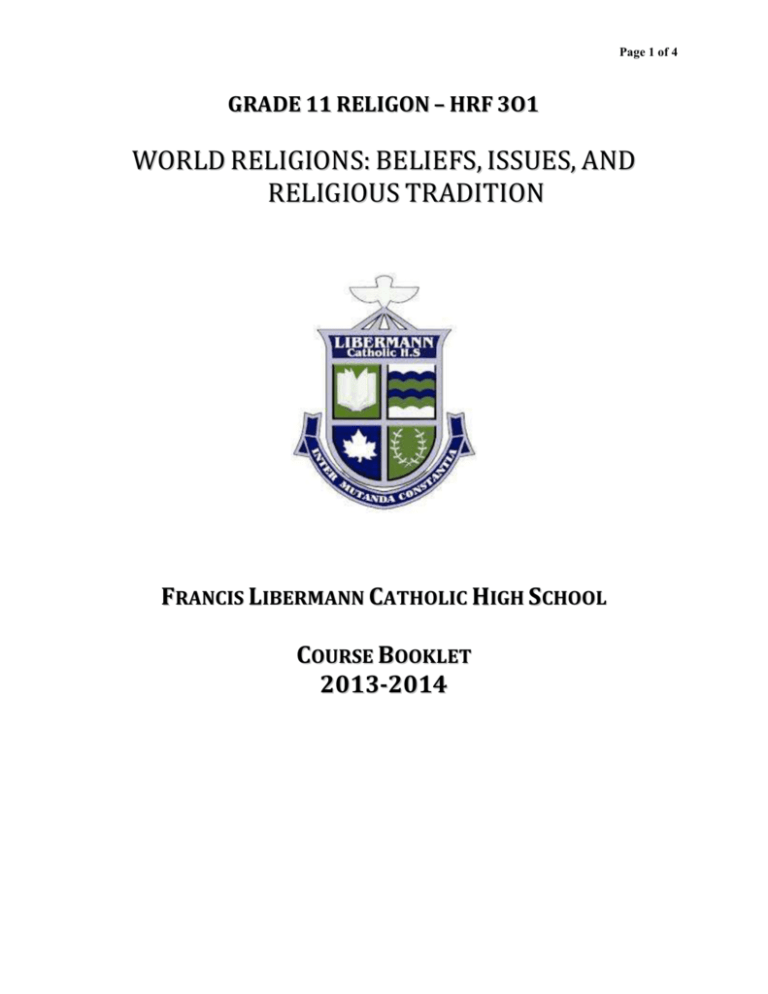
Page 1 of 4 GRADE 11 RELIGON – HRF 3O1 WORLD RELIGIONS: BELIEFS, ISSUES, AND RELIGIOUS TRADITION FRANCIS LIBERMANN CATHOLIC HIGH SCHOOL COURSE BOOKLET 2013-2014 Page 2 of 4 COURSE INFORMATION SHEET DEPARTMENT: RELIGION DATE: 09/09/2013 SECONDARY SCHOOL: FRANCIS LIBERMANN CATHOLIC HIGH SCHOOL DEPARTMENT HEAD: MS. TUZI TEACHER: Ontario Catholic Secondary Curriculum Policy Document— Religious Education from the Institute of Catholic Education (ICE) CURRICULUM POLICY DOCUMENT COURSE CODE HRF 301 PRE-REQUISITE World Religions: Beliefs, Issues, and Religious Tradition HRE 2O GRADE & TYPE 11, Open FULL YEAR / SEMESTER Full Year CREDIT VALUE 1 COURSE TITLE COURSE DESCRIPTION (AS SPECIFIED IN MINISTRY OF EDUCATION POLICY DOCUMENT) This course introduces students to the range and diversity of world religions, and examines how systems of belief affect individual lives and social relationships. Students learn about a variety of religious beliefs, teachings, traditions, and practices. Through this discovery, students develop their awareness of the place of religion in the lives of their neighbours as well as a more authentic understanding and a deeper commitment to their own faith tradition. This course helps break down misconceptions and prejudices regarding the other religious traditions. Students develop skills used in researching and investigating topics related to world religions. This course draws on expectations outlined in both the Social Sciences and Humanities and the Institute for Catholic Education policy document. This Open course is designed to broaden students’ knowledge and skills in subjects that reflect their own interests and to prepare them for active and rewarding participation in society. LISTED IN ORDER OF INSTRUCTIONAL DELIVERY STRAND / UNIT TITLES UNIT 1: ENCOUNTERS WITH THE SACRED UNIT 2: WE LISTEN—JUDAISM UNIT 3: WE BELIEVE— CHRISTIANITY HOURS 15 OVERALL EXPECTATIONS / UNIT DESCRIPTION Multicultural Manners; Stereotyping and Prejudice; Secular and Religious Worldviews; Images of God; Origins of Religious Awareness; Aboriginal Spirituality; Awe and Mystery in Religion; Daily Life, Ritual and Worship; Beliefs; Creed and Moral Code; Sacred Story; Interfaith Prayer Service 15 Sacred Story; Origins of Judaism; Moral Code; Current Challenges and Issues; Sacred Story; The God of Judaism; Creed: Beliefs; Creed: Scripture; Rituals and Practice; Moral Code; Daily Life and Family Life; The Holocaust; Interfaith Prayer Service; Unit Test 15 Sacred Story; Origins; Sacred Story: God/gods; Creed: Beliefs; Creed: Scripture; Rituals and Practice; Moral Code; Daily Life; Key Historical Figures/Events; Current Challenges and Issues (Media); Interaction with Christianity; Ecumenical Prayer Service Page 3 of 4 UNIT 4: WE SURRENDER—ISLAM UNIT 5: WE SEARCH—EASTERN RELIGIONS (HINDUISM, BUDDHISM, SIKHISM) Interaction with Christianity; Sacred Story: Origins of Islam; Sacred Story: Key Historical Figures/Events; Creed: Muslim Beliefs; Rituals and Practice; Moral Code; Daily Life; Current Challenges and Issues; Interfaith Prayer Service 20 45 Sacred Story; Origins; God/gods; Key Historical Figures/Events; Creed; Beleifs; Scripture; Rituals and Practices; Moral Code; Daily Life; Family Life; Current Challenges and Issues; Interfaith Prayer Service STUDENT EVALUATION CRITERIA TERM – 70% 10 ≤ RELATIVE EMPHASIS / WEIGHTING ≤ KNOWLEDGE/UNDERSTANDING INQUIRY/THINKING COMMUNICATION APPLICATION TERM TOTAL WRITTEN Multiple Choice Short Answer Open/Free Response Essay/Journal Papers/Reports Think/Pair/Share Case Study Conference FINAL REPORT CARD GRADE CALCULATION – 100% FINAL – 30% 40 20% 20% 15% 15% 70 RELATIVE EMPHASIS / WEIGHTING ISU Final Exam FINAL TOTAL 10% 20% TERM TOTAL + FINAL TOTAL = REPORT CARD MARK 30 ASSESSMENT FORMAT USED (EXAMPLES PROVIDED) PERFORMANCE OTHER Group Visuals Debates Teacher Observation Carousel Interviews Extended Investigations Portfolios Projects Skills Checklist Concept Mapping Socratic Presentation Vee Heuristic Focus Groups Media Presentation Jigsaw Presentations TEXTBOOK STUDENT MATERIALS EXCURSIONS COMPUTER USE COURSE RELATED WEBSITES RESOURCES (EXAMPLES PROVIDED) Exploring Religions of the World Electronic, photocopies, binder, pencil, pen, paper, highlighter Scott Mission, Holy Places tour Encouraged TBA POLICIES & PROCEDURES (EXAMPLES PROVIDED) PLAGIARISM, LATE Refer to school/departmental policy ASSIGNMENTS, MISSED WORK, ABSENCES, HOMEWORK TEACHER CONTACTS Provided in class REPORTING DATES Page 4 of 4 LEARNING SKILLS CRITERIA IN EACH REPORTING PERIOD, REPORT ON THE QUALITY OF THE LEARNING SKILLS DEMONSTRATED BY THE STUDENT IN EACH OF THE CATEGORIES IDENTIFIED ON THE REPORT CARD USING THE FOLLOWING LETTER SYMBOLS. E–EXCELLENT G–GOOD S–SATISFACTORY N–NEEDS IMPROVEMENT SKILL: WORKS INDEPENDENTLY INDICATORS: • accomplishes tasks independently • accepts responsibility for completing tasks • follows instructions • regularly completes assignments on time and with care • demonstrates self-direction in learning • independently selects, evaluates, and uses appropriate learning materials, resources, and activities • demonstrates persistence in bringing tasks to completion • uses time effectively • uses prior knowledge and experience to solve problems and make decisions • reflects on learning experiences SKILL: ORGANIZATION INDICATORS: • organizes work when faced with a number of tasks • devises and follows a coherent plan to complete a task • follows specific steps to reach goals or to make improvements • revises steps and strategies when necessary to achieve a goal • manages and uses time effectively and creatively • demonstrates ability to organize and manage information • follows an effective process for inquiry and research • uses appropriate information technologies to organize information and tasks SKILL: INITIATIVE INDICATORS: • seeks out new opportunities for learning • responds to challenges and takes risks • demonstrates interest and curiosity about concepts, objects, events, and resources • seeks necessary and additional information in print, electronic, and media resources • identifies problems to solve, conducts investigations, and generates questions for further inquiry • requires little prompting to complete a task, displaying selfmotivation and self-direction • approaches new learning situations with confidence and a positive attitude • develops original ideas and devises innovative procedures • attempts a variety of learning activities • seeks assistance when needed • uses information technologies in creative ways to improve learning for self or others SKILL: TEAMWORK INDICATORS: • works willingly and cooperatively with others • shares resources, materials, and equipment with others • responds and is sensitive to the needs and welfare of others • solves problems collaboratively • accepts various roles, including leadership roles • takes responsibility for his or her own share of the work to be done • works to help achieve the goals of the group or the class • helps to motivate others, encouraging them to participate • contributes information and ideas to solve problems and make decisions • questions the ideas of the group to seek clarification, test thinking, or reach agreement • shows respect for the ideas and opinions of others in the group or class • listens attentively, without interrupting • in discussions, paraphrases points of view and asks questions to clarify meaning and promote understanding • recognizes the contribution of group members by means of encouragement, support, or praise • seeks consensus and negotiates agreement before making decisions SKILL: WORK HABITS/HOMEWORK INDICATORS: • begins work promptly and uses time effectively • completes homework on time and with care • perseveres with complex projects that require sustained effort • puts forth consistent effort • applies effective study practices • follows directions • shows attention to detail • uses materials and equipment effectively NOTE: The above chart is a reformatting of the skills identified in the Ministry of Education’s Guide to the Provincial Report Card, Grades 9 – 12 : Appendix C: pages 27 to 29 .
